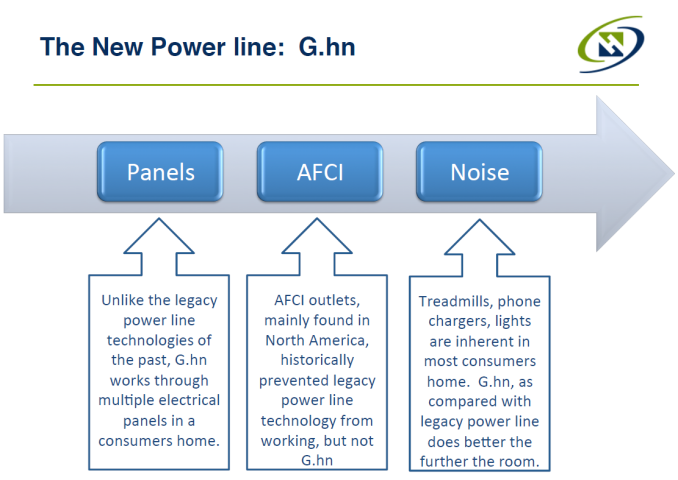Comtrend PG-9172 Powerline Adapter Review: G.hn Gets Primed for Retail Push
by Ganesh T S on May 3, 2016 8:30 AM EST- Posted in
- Powerline Adapters
- Networking
- Marvell
- G.hn
- HomePlug
- Comtrend
Concluding Remarks - What is Next for G.hn?
The Comtrend PG-9172 G.hn powerline adapter gave us the opportunity to look at G.hn technology in real-world scenarios. Our evaluation shows that the technology is quite competitive in terms of performance. It shows better resilience to noise and performs better than HomePlug AV2 products from late 2014 in almost all scenarios. In particular, AFCI circuit breakers don't seem to cause as much performance degradation in the PG-9172 as they cause in HomePlug adapters. All in all, the product delivers upon its claims and performs as expected. We hope to add some comparative numbers from the newer class of AV2000 HomePlug products in the near future.
Positives aside, Comtrend could definitely do with better default settings in the firmware (particularly for power efficiency). The firmware update process must be made more reliable. Better software QA wouldn't hurt. The HTTP interface should also be made more user-friendly with better capabilities.
It is great to finally see G.hn technology in retail. It might be painful in the short term due to initial coexistence issues, but, we can see that the G.hn side is taking a lot of effort to minimize the problems. HomePlug has a huge install base and still holds the lead, but, G.hn is no longer a vaporware competitor. That said, we would like to see more commitment to G.hn from Tier-1 vendors.
There is hardly any doubt that G.hn, considered standalone, provides a better user experience and has technical advantages. The issue has always been market acceptance and the existing install base of HomePlug demanding backwards compatibility in the pure powerline communication space.
The rising popularity of mobile devices has made Wi-Fi indispensable in the home network. However, wireless dead spots have been a major pain point for consumers. Most networking vendors have been trying to solve the wireless dead spot problem with a mixture of different products - Wi-Fi extenders, powerline adapters and other similar devices. Wi-Fi extenders usually don't deliver great user experience because the radio constantly switches between client and AP (access point) modes resulting in lowered effective bandwidth. A wired-to-Wi-Fi extender (using powerline technology) enables the extender to be in the AP mode 100% of the time, and in a different channel too. HomePlug built upon this strategy to become part of the Hy-Fi standard, aimed at making hybrid networking popular in the market. However, the Hy-Fi scheme has largely been given a cold shoulder by the market.
The HomeGrid forum and Marvell believe that the solution for a cost-effective and great user experience lies in the usage of G.hn as a backbone. The introduction of the ARRIS SURFboard RipCurrent series (a family of routers and extenders using G.hn technology) is indicative of G.hn's further push into retail channels. It is also an example of the hybrid networking idea as envisioned by the HomeGrid forum.
The announcement of the RipCurrent lineup also opens up the interoperability aspect of the Comtrend PG-9172. Given that both products are based off Marvell silicon, and both carry HomeGrid forum certifications, it shouldn't be an issue. Hopefully, our planned evaluation of the ARRIS SURFboard RipCurrent lineup will put any doubts to rest.
ARRIS is on board the G.hn train with their SURFboard RupCurrent lineup. It remains to be seen whether other Tier-1 vendors will join in. HomeGrid / G.hn seems to finally be on the right track and the momentum is now on their side. The HomePlug vs. HomeGrid tussle just got a lot more interesting.












48 Comments
View All Comments
Murloc - Tuesday, May 3, 2016 - link
powerline has always been a pain for me, it's less hassle to call up the electrician and get a cable pulled. It costs money and it needs space in the wall but at least it works with decent speed.Samus - Tuesday, May 3, 2016 - link
I've never had it work well unless you use it on circuits of the same phase. It seems as soon as you cross phases the reliability and speed fall off significantly.magreen - Wednesday, May 4, 2016 - link
Agreed. I don't think powerline has ever lived up to its billing.I think coax is the way for people who don't want to pull cable. Old cheap DECA units handle 100Mbps flawlessly. Newer bonded MOCA units are pushing actual throughput of 1 gigabit.
kmmatney - Wednesday, May 4, 2016 - link
I wasn't able to get my powerline adapters to work with my desired sockets, so had to use another plug across the room. And then one of the adapters failed after about 2 years. I switched to a cheap programmable wireless adapter. You just connected it to a computer to input your wireless settings, and then it worked on it's own after that. The wireless solution was much cheaper and overall less hassle.barleyguy - Friday, May 6, 2016 - link
I've had pretty good luck with speeds with some TP-Link powerline adapters, but I'm getting rid of them anyway and moving to 802.11AC. The problem is that they create noise on the electrical line, and I can hear it in my speakers when there's not music playing. I don't feel like the utility is worth the hassle either.cswilly - Tuesday, May 3, 2016 - link
Informative review. Looking forward to your testing with BRCM's AV2 part. As it uses 2-87MHz it should outperform Marvell's G.hn on good links.spawnbsd - Tuesday, May 3, 2016 - link
Marvell's 2nd gen 88LX5153 are starting to sample now, and support 2-100MHz in powerline MIMO. In the limited testing we've done in our labs, we're seeing near ~1Gbps throughput in common powerline topologies. Hopefully some hit retail sooner rather than later.morgi - Thursday, May 5, 2016 - link
that is awesome! what lab are you working in?Is it real TCP traffic?
nathanddrews - Tuesday, May 3, 2016 - link
It's a real shame that powerline networking hasn't received more interest and R&D. It's the perfect backbone for IoT, home automation, and retrofitting older homes that don't have ethernet or homes that struggle with radio interference.hojnikb - Tuesday, May 3, 2016 - link
I also wonder why its not adopted as a wide area network ie for internet. Instead of using phone lines use existing power network.